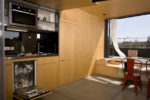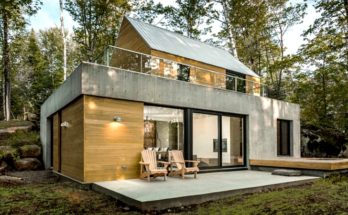I’ve always loved the concept of small spaces. I prefer being in enclosed spaces. When I was studying acting, I lived in a hostel, in my own room with a bunk bed, mini fridge, and lamp. That was it, and that small space was my cozy hideaway to work on lines, write, and dream. Though I love the idea, it’s something else to commit to it long term, and one of the issues people have most often with tiny homes or micro houses is that there’s a lot of stuff you have to have in order to live. You need a bathroom, as well as storage space, a place to prepare meals, a place to sleep, and a place to work if you have a hobby or work from home. Luckily, there are inventive people like Barbara Appolloni, who transformed Christian Schallert’s pigeon loft into something magical: an empty cube that contains everything Christian needs to work, sleep, and play. Whenever he wants to make a meal, take a nap, or type something up on his laptop, all he has to do is tap a wall, tug a handle, or press a panel and voila: the room transforms into whatever type of room Christian needs at the moment.
Imagine the bonuses of living in a space like this: you can host a small dinner party without fear of guests wandering around and seeing the stuff you pushed into the bedroom. Your cleaning routine would take next to no time, and you’d never have to race through the place looking for your keys. This would work well for people who enjoy keeping things neat and tidy and want a place for everything they own. It might not be so good for those who tend to attract clutter, since the clutter will prevent the movement of the rooms, but if you’re a person who enjoys a clear space in which to think, work, and live, this might be just the thing for you, especially if you enjoy city life but don’t want to feel like you’re living in a cramped closet. It’s also a good idea for those who like living a Spartan lifestyle, or who subscribe to the minimalist view of life.
Inspired by the clean lines of Japanese architecture, as well as the utility and practicality of furniture aboard ships, Appolloni’s experiment in Barcelona, Spain, could be the starting point for a revolution in small apartment design, especially for the younger crowd, whether they’re attending college, settling into their first job, or making a new start in a new city. Hopefully this sparks a trend among architects and builders and city planners who want to make room for more citizens.
Schallert has since opted to purchase a small hotel and have the rooms re-done in this style. You can check it out at Hotel Brummell (perks include a free yoga class). You can also watch the apartment tour in English or Spanish, on YouTube.












